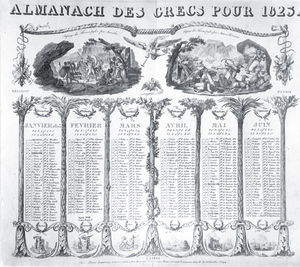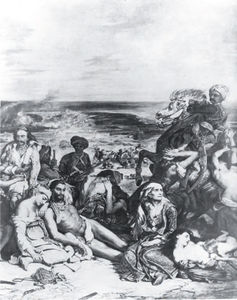7 Chios
During the early months of 1822, although the news reaching Western Europe from Greece remained overwhelmingly slanted in the Greek favour, a few disturbing reports could also be heard, mingled with the propaganda. The massacres at Navarino, Tripolitsa, and elsewhere could not be denied. Explanations and excuses could be offered for the exuberance of a long-oppressed nation suddenly rending its chains, but massacres did not fit easily into their notions of how the descendants of classical Athenians should behave although that was because they had not read enough history. Nor could indiscriminate massacres easily be reconciled with the Christian ethic as understood in the West. But if there was ever a danger of the philhellenic enthusiasm being blunted, the Turks saw to it that their own reputation as the modern barbarian horde was maintained and enlarged.
Nowhere in the Ottoman Empire did the belief in the identity of the Ancient and Modern Greeks carry greater plausibility than in the island of Chios, or Scio as it then was universally called. A rich and fertile island, it was inhabited almost exclusively by Orthodox Greeks. There were over 100,000 of them and even during the most tyrannous periods of Turkish rule, the Sciotes seemed to stand out. From the early years of the seventeenth century travellers remarked on the gaiety and gentleness of the population. The European travellers, drawing on their predecessors’ work for so many of their impressions, painted an ever more idyllic picture of life in Chios. The women in particular had a universal reputation for beauty and carelessness of morals. Their openness of manner and looseness of dress, in such stark contrast to the general situation in the Ottoman empire, stimulated the imagination and seemed to promise delights available elsewhere only in the South Sea Islands.
And in fact the Sciotes were in a highly enviable position. The island was prosperous and peaceful. Its government and tax gathering were exclusively in the hands of Greeks and the Turkish garrison was small and inconspicuous. The revival of Greek education had gone further in Chios than elsewhere in Greece and many Sciotes lived abroad in Western Europe maintaining close links with their homeland. The mainstay of the Sciote wealth and prosperity was the mastic crop which was grown to produce a kind of chewing gum. It was a luxury product exported to harems all over the Middle East, and innumerable bored Turkish ladies were as strongly addicted to it as their menfolk were to tobacco. As a result Chios was able to make a substantial contribution to the imperial treasury while at the same time maintaining only a light level of taxation. In the years before the Revolution, the island appeared to be a living example of the regeneration of Greece in action. The Ottoman Government enjoying secure revenues and untroubled by administrative costs regarded it as one of the most valuable provinces of the Empire.
When the Revolution broke out in Greece the leading Sciotes saw no reason to join the revolutionaries. They realized that no government of Europeanized Greeks and undisciplined Moreotes was likely to give them the undisturbed security, prosperity, and virtual independence which they enjoyed under the Turks. They also realized that they were situated far too close to the Turkish heartland in Asia Minor to be safe. At some points Chios is only two miles from the Asian mainland and the chief town is only seven miles from the Turkish port of Chesme. The Turkish main fleet, although harassed by the small ships of Hydra, Spetsae and Psara, was a formidable force. The Sciote leaders had little hesitation, therefore, in proclaiming their loyalty to the Ottoman Government and giving over prominent men as hostages for the good conduct of the islanders.
From the very beginning of the Revolution, however, it had been the aim of the revolutionaries to embroil as many Greek communities as possible in their struggle. Their technique was a simple one. It was to engineer some atrocity against the local Turkish population; after such an occurrence the Ottoman Government could no longer be expected to see a distinction between loyal and disloyal Greeks. The first revolutionaries, spurred on by the overseas conspirators, had ruthlessly exploited this method to draw into the conflict many Greek communities who would have preferred to stand aside. And many Greeks particularly in Northern Greece had paid the inevitable penalty in 1821. The prosperous and contented Sciotes were an obvious target for these tactics, especially as their happy condition was much envied by their poorer neighbours in Samos.
In March 1822 several hundred armed Samians landed in Chios, destroyed a few mosques, and proclaimed the Revolution. The Turks retired into the citadel. Reinforcements arrived from mainland Greece, including a few European officers, but they made little progress in besieging the citadel. Many Sciotes decided to join the Revolution. When the news reached Constantinople, the Ottoman Government reacted in the normal way. Orders were given to put the hostages to death and Sciotes living in Constantinople were rounded up and imprisoned. The Ottoman fleet, which had just sailed from the Dardanelles, was given the task of recapturing the island from the insurgents. The Government, which had believed that it had by now successfully contained the Revolution within a small area, was especially indignant at the boldness of the revolutionaries. It was said that the ladies of Constantinople felt incensed at the prospect of losing their precious mastic supplies and encouraged the Sultan to take a severe line. More probably, the Government felt that an example had to be set to prevent Lesbos and other islands from going the same way and to maintain the precarious loyalty of the large Christian minorities in Constantinople and elsewhere in the Ottoman Empire.

11. Part of the Philhellenic Calender of 1823, with the Saints’ days and Anniver-saries of the Battles of the Greek Revolution. The later are mostly imaginary.
The Turks of Asia Minor decided to take their revenge in their own way. When the Turkish forces landed in Chios from the fleet they were joined by thousands of armed undisciplined Turks who crossed in small boats from the mainland. And as on the previous occasions the Moslem religious authorities encouraged the people to look on the recapture of Chios as a holy war. An unofficial regiment of imams was even formed which crossed the narrow strait. At the first sign of the Turkish counter-attack the Samians abandoned their enterprise, pausing only to kill off all the Turks they had captured. The Sciotes, with no means of escape, were left to their fate.
In the first days after the Turkish troops landed, thousands were killed in the streets and thousands more were rounded up for transport to the slave markets. The main towns were given over to plunder. The Sciotes, who were largely unarmed, escaped as best they could or attempted a feeble resistance. Two parties, each of over two thousand, tried to protect themselves in monasteries in the hills but they all perished when the monasteries were set on fire.
It seems to have been the official Turkish policy to preserve as much of the island as possible and especially to leave untouched the mastic-growing villages on which the revenues of the island depended. But they were unable to restrain the appetites that had been let loose. The Turks on the mainland saw their comrades returning home laden with plunder and leading their slaves. No one wanted to be left out. Self interest and religious duty pointed in the same direction and thousands more Turks crossed to join in. They burst into the mastic villages and soon the whole of Chios was given over to massacre and destruction. One of the most peaceful and thriving communities in the Levant was utterly and irretrievably ruined. It has never properly recovered.
As always, it is impossible to assess accurately how many thousands were killed, left to die, or taken into slavery. The customs authorities gave official certificates for 41,000 slaves, mainly women and boys, and 5,000 of these were sent to the slave market at Constantinople to be sold at about 100 piastres each. The normal slave market was too small to cope with the numbers and many had to be exposed for sale in the fish market or on the street corners. The recalcitrant and the inconsolable were killed off as being of no commercial value and their bodies left to rot in the streets or by the water’s edge in the usual Turkish way with their severed heads between their legs, to be devoured in time by the scavenging dogs which infested the city. Passers-by shuddered at the screams of boys being systematically circumcised in batches of forty or fifty to symbolize their forcible conversion to Mohamedanism. Large brothels of women and boys appeared all over the city.
The Christian population of Constantinople, Greeks and Armenians, had disappeared from the streets when the crisis broke out but, inevitably, many had nowhere to hide. As had happened a year before, bands of Turks, urged by the Moslem religious authorities to take up arms, roamed the streets killing any stragglers they could find. The Government, fearing that the Christians in Constantinople might be planning a revolution, took no steps to control the mobs of terrorists. The Patriarch of the Armenians had been ordered to prevent his people having any dealings with the Greeks: all Greeks were to be dismissed from employment with the sole exception of wet nurses, and even they were ordered to terminate the connection as soon as nature allowed.
In accordance with the custom of regarding every individual as sharing responsibility for the actions of his community, the Sciotes who lived in Constantinople were deliberately hunted down. For them simple death was not considered sufficient. They were taken to the torture house within the Seraglio and subjected to the highly refined punishments of the East, bastinadoed, hung upside down and beaten, suspended by hooks through the ears with weights attached to their feet, their finger nails pierced with needles, their limbs and joints broken by screws, or slowly burnt to death in huge ovens.
Trophies of the Sultan’s great victory were exhibited to the people of Constantinople in the traditional manner. Sacks of human heads, noses, and ears from Chios were strewn around the streets. They lay where they fell sticking to the feet of pedestrians, and even in the food markets no Turk would deign to remove the putrefying masses of human flesh. The Sultan and his train of followers on their weekly procession to and from the mosque were too proud to step aside, and their horses unconcernedly trampled the ghastly remains of his Christian subjects into the mire.

12. Scenes from the massacres of Scio.



